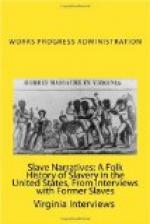“De Colonel hated de sight ob mean niggers. We would ride up to a negro settlement, and tell de niggers we wuz organizing a colored militia to catch Cullen Baker and his gang. Most ob de negroes would join, but some ob dem had to be encouraged by Colonel Baker’s big gun. De recruits would be lined up in an open field fo’ drilling. And dey sho wuz drilled. Colonel Baker and his men would shoot them by the score. Dey killed 53 at Homan, Arkansas, 86 at Rocky Comfort, (Foreman) Arkansas, 6 near Ogden, Arkansas, 6 on de Temple place, 62 at Jefferson, Texas, 100 in North Louisiana, 73 at Marshall, Texas, and several others.”
“All of de big planters wuz friendly to Cullen Baker. I have carried supplies many times frum de big plantations—Hervey, Glass, and others—to Cullen Baker. De Colonel always carried a big double-barrel shotgun. It must have been de biggest shotgun in de world, not less den a number eight size. He whipped 16 soldiers at Old Boston wid dis gun one time.”
“I saw Colonel Baker killed. We had just arrived at his father-in-law’s house and I wuz in the horse lot, about 50 yards from de house, when Joe Davis. Thomas Orr and some more men rode up.”
“De Colonel wuz standin’ by de chimney an did not see dem come aroun’ de house. Dey killed him befo’ he knew dey wuz aroun’. One ob de men asked Mr. Foster, “Where at dat d—n nigger?” I ducked down and crawled in under de rail fence and ran—I didn’t stop ’til I wuz deep in the Sulphur River bottoms. Every minute my heart seemed like it wuz goin’ to jump right out uv my mouth. I wuz the worst scared nigger that ever lived.”
“I have lived many years since dat time. De times and ways of livin’ have changed. I ’member killing deer where the Texarkana National Bank stands, way befo’ Texarkana wuz even thought of. This place wuz one of my favorite deer stands. Nix Creek used to be just full ob fish. What used to be the best fishing hole aroun’ here is now covered by the Methodist Church (Negro), in East Texarkana. Dr. Weetten had a big fine home out where Springlake Park is. He wuz killed when thrown by a buckin’ horse. All of de young people I knew den have been dead many years.”
Foods
The question of eating special food on a particular day immediately brings in mind Thanksgiving Day, when turkey becomes the universal dish. Perhaps no other day in the year can be so designated, except among a few religious orders when the eating of meat is strictly prohibited on certain days.
The belief that negroes are particularly addicted to eating pork is well founded, as witness the sales of pork to colored people in most any meat market. But who could imagine that cotton-seed was once the universal food eaten in this vicinity by the colored people? That, according to Doc Quinn, a former slave, and self-styled exmember of Cullen Baker’s Gang, was the custom before and shortly after the Civil War.




